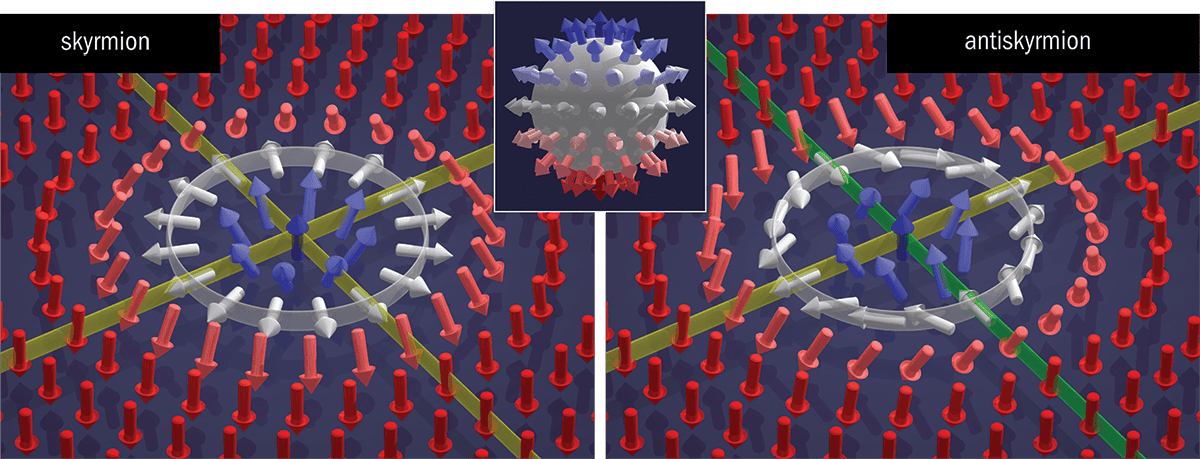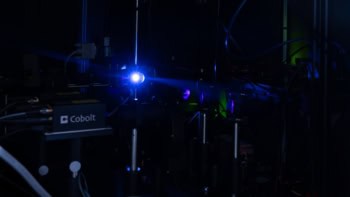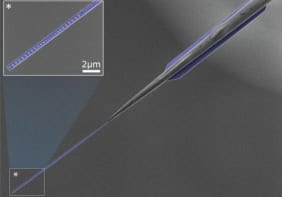Kirsten von Bergmann and André Kubetzka explain the nature of a type of quasiparticle known as a magnetic skyrmion, which looks promising as a “bit” for future data-storage technology

Having a particle or even a whole class of particles named after you is one of the great legacies in physics. Those who share this rare honour include Enrico Fermi, Satyendra Nath Bose and Peter Higgs. But have you ever heard of the British physicist Tony Skyrme? In the early 1960s Skyrme developed a theoretical model describing forces in atomic nuclei. Within his theory, topological solitons emerge as particle-like solutions of nonlinear field equations, which five years before Skyrme’s death in 1987 became known as skyrmions.
Recently, one variety of skyrmion, the magnetic skyrmion, has emerged as a hot topic in physics. This is partly due to its topological properties, which result in a rich variety of magnetic phenomena, and partly from its potential as a “bit” in future data-storage devices. Rather than being a fundamental particle, such as an electron, magnetic skyrmions are quasiparticles, which can emerge as a collective phenomenon in magnetic materials with broken inversion symmetry. Like real particles, such as atoms, they are localized, can move around, interact with each other, form lattices and have antiparticles. However, skyrmions are confined to the magnetic material as their carrier and have no existence outside it.
1 Magnetic knots

Sketch of a skyrmion and an antiskyrmion. Each arrow represents the local magnetization direction, which varies from upwards (blue) in the centre through horizontal (white) to downwards (red) in the surroundings. While these two quasi-particles are topologically distinct, they both wrap a unit sphere exactly once (see inset). If you follow the arrows indicated by the white circles, they rotate in different directions, which means their topological indices have the opposite sign: +1 for skyrmions and –1 for antiskyrmions.
In a magnetic material, the atomic magnetic moments are coupled with each other and so produce a vector field of magnetization that is almost continuous. In a ferromagnet, for example, all magnetic moments point in the same direction. In a particle-like skyrmion, however, the magnetic moments in its centre point in the opposite direction to those of its ferromagnetic surrounding (figure 1). These magnetic configurations are characterized by a quasi-continuous rotation of the direction of the atoms’ magnetic moments relative to their neighbours. In fact, there are two basic types: the skyrmion and the antiskyrmion. The difference between them is the way they locally twist: skyrmions have rotational symmetry, whereas antiskyrmions have a two-fold rotation axis, i.e. they look the same only when rotated by 180°. The shape of such skyrmions and antiskyrmions is very robust and in some sense they behave like particles, living in a sea of parallel magnetic moments pointing opposite to the one in the centre.
Skyrmions and antiskyrmions, which are like knots in the magnetization, are classified by their topological index. Annihilating a knot turns out to be easy when using a knot with opposite topological properties
Skyrmions and antiskyrmions, which are like knots in the magnetization, are classified by their topological index, which can be viewed as the number of windings around a unit sphere. Unwinding such a single knot would be impossible, if, in an imaginary world, magnetic materials were continuous rather than being composed of atoms. However, annihilating a knot turns out to be easy when using a knot with opposite topological properties. A skyrmion and an antiskyrmion, if brought together, can smoothly unwind to form the topologically trivial ferromagnetic state, similar to the situation in particle physics where electrons and positrons annihilate when brought together.
Keeping stable
In the real world, topology alone cannot stop skyrmions or antiskyrmions from collapsing to the ferromagnetic state. Instead, their stability depends on an energy barrier related to the so-called Dzyaloshinskii–Moriya interaction (DMI), a phenomenon that occurs due to spin–orbit coupling (the interaction of spins with their motions). The DMI stabilizes skyrmions and stops them collapsing, but usually it does not contribute to the energy of an antiskyrmion, which causes the latter to be unstable.
The DMI in general favours adjacent magnetic moments having a twist between them, rather than them being parallel, but importantly it also selects a material-specific rotational sense. Analysing the two magnetic objects in figure 1 demonstrates that the rotation direction is coherent across a skyrmion, but within the antiskyrmion it is changing: following the indicated yellow lines from left to right, the rotation is clockwise, whereas for the perpendicular green line across the antiskyrmion, the rotation is anticlockwise. Let’s consider a case where the DMI favours a clockwise rotation of the magnetization. Speaking in terms of energy, the antiskyrmion gains DMI energy in one direction and pays the same energy penalty perpendicular to it. In contrast, the skyrmion gains DMI energy in every direction, making it the energetically more favourable state.
The DMI is able to impose a unique rotational sense but is itself subject to selection rules: it may only occur in systems that lack inversion symmetry; in all other systems the effective DMI vanishes. Typical skyrmion materials are thus either those with chiral crystal structures, or magnetic films, which lack inversion symmetry due to the presence of a surface or interface.
Harnessing skyrmions
The current interest in skyrmions is fuelled by their promise for future information technology. Their potential to be harnessed in this way is down to their magnetic twist, which interacts strongly with electrical currents. Electrons traversing through such spin “textures” can transfer their spin to atomic magnetic moments and thus induce a torque, resulting in a movement of the spin texture through the material. Pure spin currents generated in an adjacent material can also trigger a motion, which is then sensitive to the magnetization rotation direction, i.e. clockwise rotating skyrmions move in one direction and anticlockwise twisting states in the other.
2 Under the microscope

(a) This spin-resolved scanning tunnelling microscopy measurement shows skyrmions in an ultrathin magnetic film made of palladium and iron atoms on a highly ordered iridium surface in a magnetic field, B, of 1.1 T, at a temperature of 8 K. Colours have the same meaning as in figure 1. (b) The precise orientations of the atomic magnetic moments that form the indicated tiny magnetic knot were derived from such a measurement.
The experimentally realized sizes of skyrmions range from the micron- down to the nanometre-scale, eventually comprising barely a few dozen atoms. An example of particularly small skyrmions is those that can form in a bi-atomic layer of palladium and iron on a highly ordered iridium single-crystal surface (figure 2a). Due to the magnetization of the probe tip, the tunnel current is sensitive to the magnetization of the sample, and in this case a magnetization parallel to the tip magnetization is coloured red, whereas the opposite magnetization component is blue. The diameter of a skyrmion (the distance between opposite in-plane spins) depends on the magnetic interaction parameters and the external magnetic field and for those displayed is about 3.5 nm, which corresponds to about 13 atomic distances. Figure 2b shows the atomically precise sketch of the spin structure, which was derived from the experiment.
As for how magnetic particle-like states could be used in information technology, in 2008 IBM fellow Stuart Parkin and colleagues proposed that magnetic domain walls could be used as information carriers (Science 320 190). This idea was extended to magnetic skyrmions in 2013 by Albert Fert and colleagues at the Université Paris-Sud (Nature Nanotechnology 8 152). The presence of a skyrmion at a specific position could mean a “1” and the absence a “0”.
In this so-called “racetrack memory”, magnetic domain walls, or alternatively skyrmions, are moved through a magnetic material by electrical currents (figure 3). In contrast to a conventional computer hard disk where the recording medium is moved mechanically with respect to the read/write heads, in racetrack memory the magnetic bits move along the racetrack, but the racetrack itself (as well as the read/write elements) remains stationary. Lacking any moving mechanical parts, such a device is extremely shock-resistant and therefore also ideal for mobile applications. In addition, the racetrack concept can be a 3D information storage medium, whereas hard drives are 2D. This memory concept, in combination with small skyrmion sizes, has the potential to boost the storage density of data.
Several challenges need to be tackled, however, before skyrmions can be used in racetrack memory for everyday applications. Ordered skyrmion lattices in chiral magnetic bulk crystals can be moved smoothly by electrical currents, but for technology, independent magnetic skyrmions are crucial for the representation of a bit. Such individual magnetic skyrmions are found in magnetic thin-film skyrmion materials, which are compatible with current magnetic multilayer device technology. However, in many of these materials the skyrmions get stuck or “pinned” at defects such as grain boundaries or imperfections, which is a problem. Also, the skyrmions that are stable at room temperature are still one or more orders of magnitude larger than the small isolated nanoscale skyrmions, such as those in figure 2, that have been observed at low temperatures.
3 Memory of the future

A skyrmion-based racetrack memory would involve equidistant “bits”, where the presence of a skyrmion indicates a “1” and the absence of a skyrmion indicates a “0”. These bits would be moved along a magnetic track (red), using electrical currents, and they would pass a stationary read/write element. The element depicted here consists of a contact (yellow) that is separated from the track by a tunnel barrier (transparent).
Towards skyrmion devices
Size does matter. Bits need to be small, but the tinier they get the harder it is to do reading and controlled writing. However, it has been shown in scanning tunnelling microscope experiments that it is possible to write nanoscale skyrmions reliably using electric-field-driven switching. This proof-of-principle experiment exploits the electric field between the probe tip and the sample. An electric-field-driven mechanism is also compatible with the racetrack memory concept by using a metallic contact, separated from the magnetic track by a tunnelling barrier. This could serve as a combined element that both reads and writes the information, as in figure 3.

Synthetic antiferromagnets host room-temperature skyrmions
In principle, every operation needed for a racetrack memory based on magnetic skyrmions – the all-electrical movement, and the reading and writing of the information – has been demonstrated. However, the individual tasks were realized in different materials, for different length scales of skyrmions, and in different temperature and magnetic-field regimes. The challenge now remains to unify all of these operations into a single prototype device.



